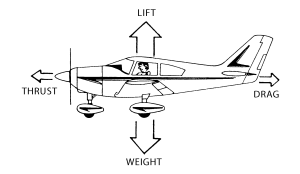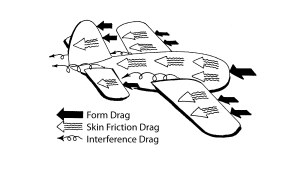This is the second part of this two part series on the four forces of flight, where we’ll introduce thrust and drag. You can find our intro to lift and weight here. William Kershner’s The Student Pilot’s Flight Manual by will explain thrust and drag:
Thrust
Thrust is furnished by a propeller or jet. The propeller is of principal interest to you at this point, however.
The theory of propellers is quite complicated, but Newton’s “equal and opposite reaction” idea can be stated here. The propeller takes a large mass of air and accelerates it rearward, resulting in the equal and opposite reaction of the plane moving forward.
Maybe it’s time a few terms such as “force” and “power” should be cleared up. Thrust is a force and, like the other three forces, is measured in pounds. A force can be defined as a tension, pressure, or weight. You don’t necessarily have to move anything; you can exert a force against a very heavy object and nothing moves. Or you can exert a force against a smaller object and it moves. When an object having force exerted upon it moves, work has been done. Power is work per unit time.
The most common measurement for power is the term “horsepower.” The airplane develops horsepower within its cylinders and, by rotating a propeller, exerts thrust. In straight and level, unaccelerated, cruising flight the thrust exerted (pounds) is considered to equal the drag (pounds) of the airplane.
Drag
Anytime a body is moved through a fluid (such as air), drag is produced. Drag acts parallel to and in the same direction as the relative wind. The “total” drag of an airplane is composed of two main types of drag.
Parasite drag—the drag composed of (1) “form drag” (the landing gar and radio antenas, the shape of the wings, fuselage, etc.), (2) skin friction, and (3) airflow interference between components (such as would be found at the junction of the wing and fuselage or fuselage and tail). As the word “parasite” implies, this type of drag is of no use to anybody and is about as welcome as any other parasite. However, parasite drag increases as the square of the airspeed increases. Double the airspeed and parasite drag increases four times. Triple the airspeed and parasite drag increases nine times.
Induced drag—the drag that results from lift being produced. The relative wind is deflected downward by the wing, giving a reward component to the lift vector called induced drag (the lift vector is tilted rearward). The air moves over each wing tip toward the low pressure on the top of the wing and vortices are formed that are proportional in strength to the amount of induced drag present. The strength of these vortices (and induced drag) increases radically at higher angles of attack so the slower the airplane flies, the much greater the induced drag and vortices will be.
You can purchase The Student Pilot’s Flight Manual on our website at ASA2Fly.com, which contains even more resources for student pilots.
Have a safe journey!






